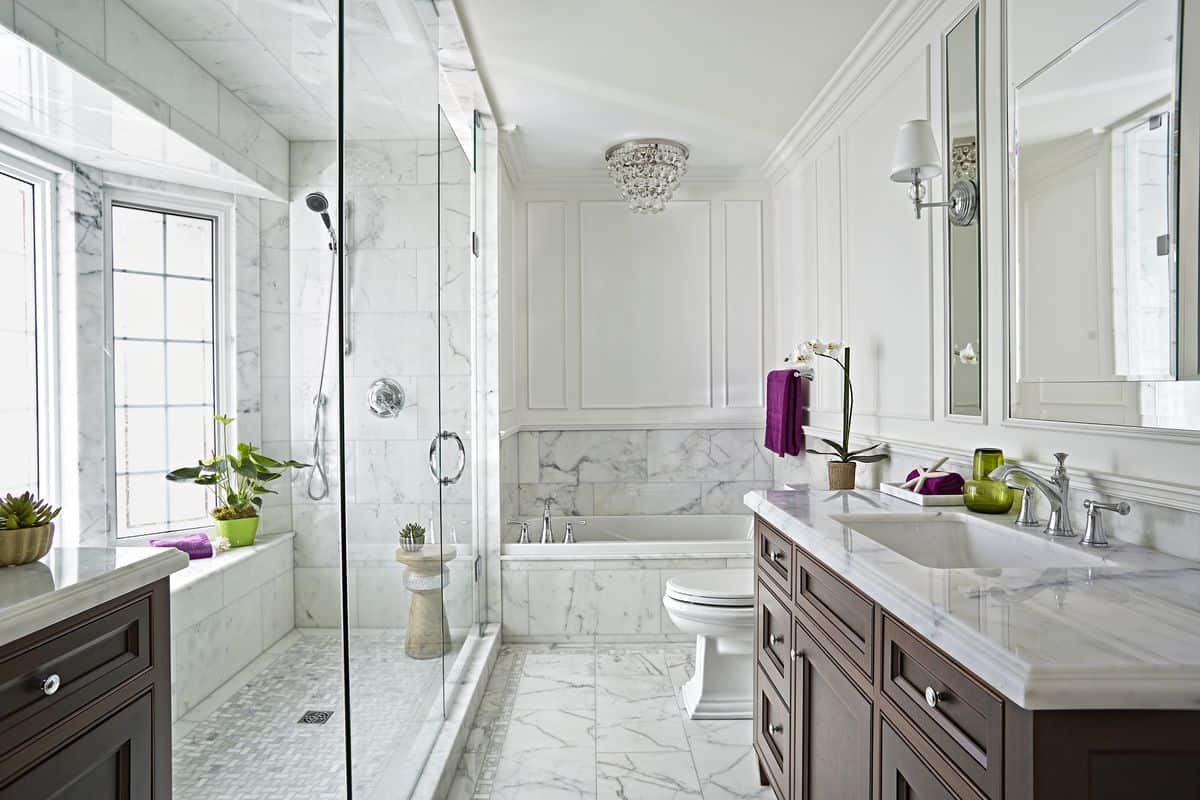Featuring natural stone in your home is an excellent way of bringing a sense of luxury to your house and bringing your house to life. The bathroom in particular offers wonderful opportunities to infuse stone either in the shower, flooring, walls or vanities. However, knowing which type of stone is better for the bathroom, granite or quartz or even marble, is a different story.
If you’re not sure which type of stone is right for you, we’ve broken down everything you need to know right here and if you’re still not sure, make sure to get in touch with our team today.
Quartz, Granite and Marble
Quartz
Quartz or engineered quartz as it’s called is actually not a natural stone at all. Man-made and manufactured in a factory, quartz is a mixture of about 90% natural stone and 10% polymer pigments and resins. Because of the fact that it is in fact an engineered stone it offers some unique advantages and disadvantages when applying in your home, but we’ll get to that in just a moment.
Don’t confuse quartz with quartzite, which is indeed a naturally occurring stone and is often contained within engineered quartz.
Marble
Marble, one of the most iconic natural stones, is a metamorphic rock that is formed inside the Earth over time and with intense heat and pressure. Known for its silvery veins and clouding, it is a highly practical and visually stunning stone that can be used throughout the house. Marble is commonly quarried from Italy, Brazil and the US.
Granite
Granite, another popular natural stone for construction, is an igneous rock formed through compressed magma from a volcano. In addition to its hardy and durable features, granite is known for its granular composition bringing a unique visual depth to any application in which it is included. Granite can be found around the world including Italy, Brazil, the US, India and China.
Which to use: marble, quartz or granite for your bathroom?
Aesthetic
When it comes to the aesthetic of each stone, it’s a matter of personal preference. Quartz, being manufactured, comes in more uniform and predictable patterns and shades. It can also be produced at any size and shape so you don’t have to worry about visible seams.
Granite and marble however are quarried stone so every piece is unique and unlike any other. Both stones come in a variety of colours and shades and while marble typically has beautiful veining, granite is known for a denser concentration of different flecks of colour.
Cost
If the price point of each type of stone is of the most concern for you, quartz will likely be the cheaper option. But this is not necessarily so. Granite and marble can both fetch quite expensive price tags but they also range considerably, so you can find stone for just about any budget. Plus, remember to consider stone as an investment and not just an initial expense.
Maintenance
Using marble or granite in bathrooms is very practical in terms but being a porous and natural stone, it is more porous than quartz and other engineered materials. That’s not to say it’s difficult or expensive to maintain. Simply keep it cleaned regularly with soap and warm water, and remember to have it professionally resealed every few years. While quartz is non-porous it still requires basic cleaning to keep it shiny and beautiful.
Durability
Mable, quartz or granite for bathrooms are all good choices. Each stone is durable and hardy, especially when well maintained and offers strong resistance to basic wear. Nonetheless, being more porous, natural stones are relatively easier to stain or scratch than engineered quartz. However, quartz is more likely to be damaged by heat and UV light.
Environmentally Friendly
Quartz, marble and granite all offer different advantages on the environmental side of things. While marble and granite require less manufacturing and thus energy use because they are quarried, they do need to be transported around the world. On the reverse side, while quartz does require fabrication in a factory, it does recycle and reuse quarried stone offcuts in the composition of the man-made stone.
Repairs
Despite their hardy nature, whether you’ve installed marble, granite or quartz, there’s always the possibility of damage. From small chips to long cracks, sometimes it’s just unavoidable. Fortunately, all three types of stone can be fixed with special adhesives, resins and epoxy products. For large-scale damage, we do recommend you contact a professional regardless of what type of stone you are using in your bathroom.
Value Add
Once again, all three types of stone are popular and valuable materials for use in your home and bathroom, but if you’re particularly interested in the add on to your house’s resale value, natural stone–either granite or marble–is recommended.
Uniqueness
As we mentioned briefly before, engineered stone–quartz–is produced in a factory and so it is unlikely that the stone applied in your bathroom is going to be 100% unique and unreplicated. Granite and marble in your bathroom on the other hand is quarried straight from the ground and the slab cut to size for your vanity or shower tiles. That means every individual stone is unique and that there is no other stone in the world quite like it.
Let’s Talk More About Which Stone is Better For Your Bathroom Today
At the end of the day, whether you choose quartz or granite or marble for your bathroom, we’re sure you will be more than happy with the choice. Though making that choice for your specific application and according to your preferences can understandably be overwhelming.
The friendly team here at Euro Marble are always happy to help. So give us a call today and let’s talk about all things bathroom stone!





